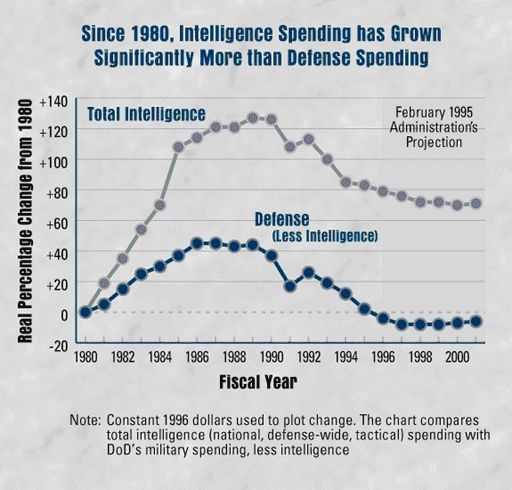ARE WE SPENDING ENOUGH ON INTELLIGENCE? WE PROBABLY ARE!
Well, the DNI implied back on 30 October that the United States will spend $43.5 billion on intelligence in FY 08 and the security of the republic seems not to have been impaired. In fact there has been a paucity of public discourse about whether this amount is to much or to little to spend on for intelligence ----- whether we are a nation at war or not. Interesting given all arguing back and forth over the years about whether or not providing the top line budget number for intelligence would or would not do harm to national security.
I say implied because the Washington budgetary cognoscenti know that $43.5 billion is a low ball number since it only includes what is in the National Intelligence Program (NIP), leaving those without clearance and need to know wondering how much the Military Intelligence Program for FY 08 is and what amount from the Iraqi War supplementals are spent on intelligence. I always contended inside the SCIFed area of Office of Naval Intelligence that the Intelligence Community wanted to keep its top line budget classified in the mid 90s because the amount spent on intelligence each year was about equal to the amount Mrs. Clinton said was needed to fund a national health care program and there was reasonable concern (meaning I was concerned) that if given a choice the American people would choose to fund heath care rather than intelligence.
As Ross Perot used say when he was running against George H. W. Bush and William Jefferson Clinton back in 1992 “let’s take a look under the hood at these [IC] numbers.” The following chart from the Aspin-Brown Commission shows total intelligence funding grew by 125 percent in real (constant dollar) terms from 1980 to 1989 as part of the Regan Defense Build up and yet the IC was as surprised by Iraq’s 1990 invasion of Kuwait as it was Egypt crossing the Suez Canal in 1973. Then there was the collapse of the Soviet Union, which the IC seemed to be learning about with the rest of us from watching CNN and listening to the BBC. The chart goes on to show Intel spending increases declined after 1989, but remained at a level 80 percent higher than the 1980 figure, yet the IC still could not warn of the African Embassy Bombings, the Cole Attack, or 9-11; nor could it get the Iraqi Weapons of Mass Destruction (WMD) NEI right.

As damning as a chart like this seems, I would be the first to say return on investment (ROI) is a false metric for intelligence spending. The more relevant question for intelligence spending is what should the nation be spending to get the effects it needs from its intelligence capabilities? I am certainly not interested in any fool saving money at the expense of national security!
Still these budgetary numbers suggest to me, and I believe to the DNI, that getting the right effects is more about what the IC budget is spending on than on how much more it needs to spend to make us secure. Just the savings from being able to reuse intelligence through collaboration, improved business practices, better leveraging of private sector Research & Development (R&D), and making contractor security clearances less costly should free up money needed to recapitalize the IC and fund new initiatives. Not quite how Mike McConnell might put it, but in the end what I am describing is the business case rational behind his 500 Day Plan for the IC.
Based on observed behavior, I believe the current DNI has taken a hard look at the numbers and assessed that the American people are not overly concerned by what the IC is costing them year over year. It seems he also senses that when gas prices are rising and the stock market is dropping asking for more funding for intelligence will only lead to an unnecessary debate about how more money for intelligence will make the nation more secure. What do you think?




Comment
I agree that the public
Within the IC we used to
I would like to see a similar
Intelligence on the cheap
Comments